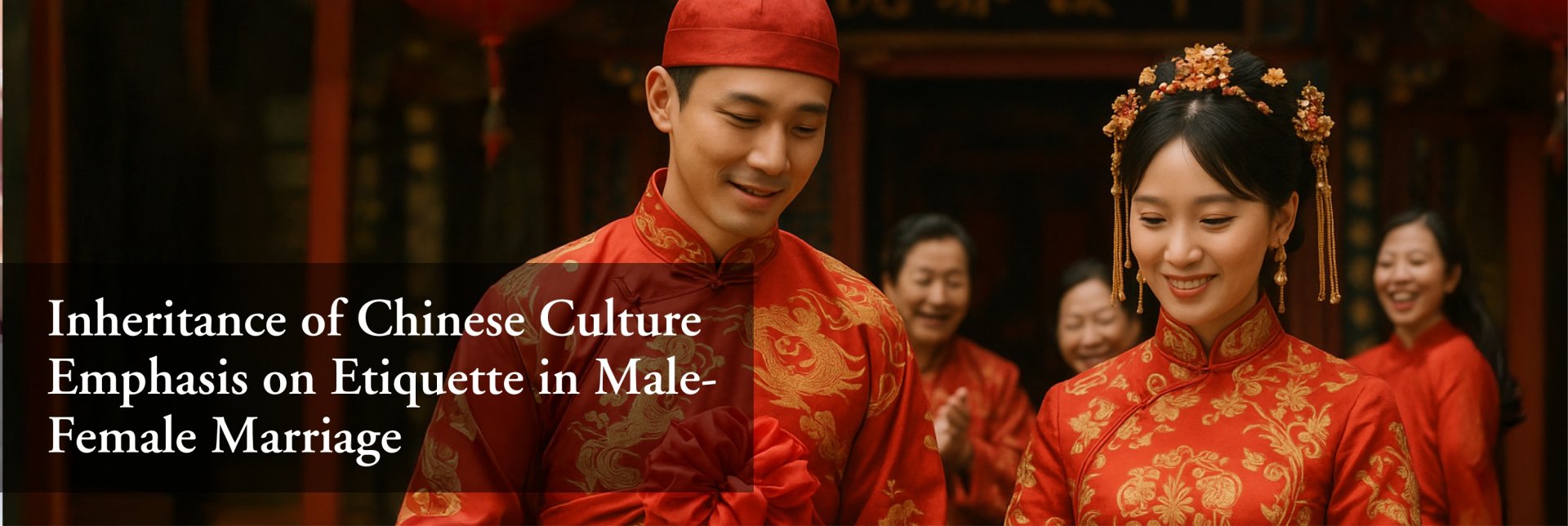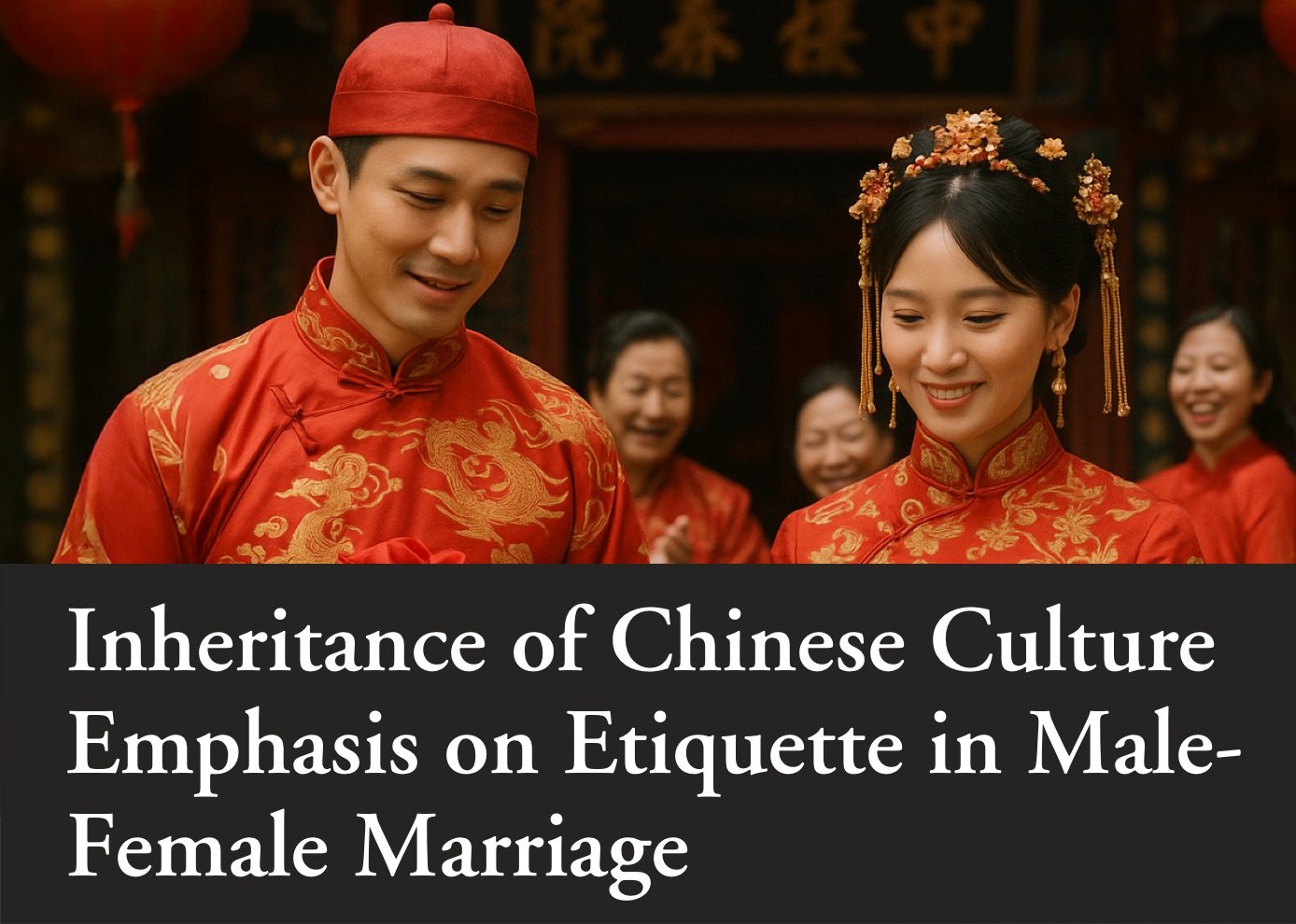Inheritance of Chinese Culture:
Emphasis on Etiquette in Male-Female Marriage
A formally arranged and legally recognised marriage
In ancient China, great importance was attached to marriages that were formally arranged and legally recognised. Advocating that only marriages arranged with "the consent of parents and the words of a matchmaker" conformed to etiquette.
During the Spring and Autumn and Warring States periods, the State of Yan attacked the State of Qi. The crown prince of Qi, Fazhang, fled in a hurry, changed his surname and name, and worked as a servant in the home of Tai Shi Jiao in the city of Ju. At that time, Tai Shi Jiao's daughter saw that Fazhang had an extraordinary appearance and demeanour and secretly fell in love with him. They even privately made a marriage contract. Soon afterwards, Qi officials discovered the prince's whereabouts and supported him in ascending the throne, becoming King Xiang of Qi. After ascending the throne, King Xiang of Qi immediately sent a procession with drums and music to marry Tai Shi Jiao's daughter as his queen. When Tai Shi Jiao learned that his daughter had privately made a marriage contract with someone, he flew into a rage and scolded, "It is too disgraceful for a woman to marry without a matchmaker and make her own decision." From then on, he severed his relationship with his daughter.
The above story shows that the matchmaker played a significant role in ancient Chinese marriage etiquette. The saying "men and women do not associate without a matchmaker" became the norm for marriage.

Six Etiquettes of Wedding
Since the Zhou Dynasty, China has had a complete set of marriage rituals known as the "Six Etiquettes," namely Nacai(Proposal), Wenming(Birthday Matching), Naji(Presenting Betrothal Letter), Nazheng( Presenting Wedding Gifts), Qingqi( Picking A Wedding Date) and Qinying( Wedding Ceremony)
Nacai(納采)
This refers to the male family sending a matchmaker to propose marriage to the female family formally. After obtaining the permission of the female family's parents, gifts such as geese, mandarin ducks, fish, deer, cotton, ducks, etc., are presented. These gifts all carry auspicious symbolic meanings.
Wenming(問名)
Commonly known as "asking for the female’s birth date and birth hour”. This involves the male family sending a matchmaker to inquire about the female's name, birth date, place of origin, etc., to ensure the compatibility of the potential bride and groom.
Naji(納吉)
If the compatibility is good (i.e., a good omen), according to astrology, they send someone to inform the female family of the good news and send out the betrothal letter, which is called Naji. After Naji, the marriage is considered officially confirmed.
Nazheng(納徵)
This refers to the male family presenting betrothal gifts, cakes, and other presents to the female family, which are now known as the "bride price," "grand gift," or "engagement gift." Nazheng holds great significance in the wedding ceremony process, as it marks the complete establishment of the marriage contract.
Qingqi(請期)
This involves the male family selecting an auspicious wedding day and informing the female family to obtain their consent. Even today, people still attach great importance to the day of the wedding ceremony, often carefully negotiating it between the bride and groom, commonly referred to as "picking a date" or "proposing a date."
Qinying ( 親迎)
This refers to the groom personally going to the female family to fetch the bride, which is the most solemn ceremony in the wedding.
The above six etiquettes were mainly practised among the aristocracy and scholar-officials during the Zhou Dynasty, while the ordinary people often simplified and adapted them. However, these six etiquettes have become the foundation of later marriage rituals, with their main ceremonies still being followed today, such as the "grand gift," "picking a date," "fetching the bride," and "visiting the bride's parents three days after the wedding." At the same time, other cumbersome formalities have been simplified.

Auspicious Customs and Traditions
Hong Kong is a place where Eastern and Western cultures converge. Many people hold weddings where they wear both traditional Chinese qipao and Western wedding dresses, blending Chinese and Western wedding ceremonies to create a unique flair. Among these, "auspiciousness" is one of the connotations of marital culture, which is often seen in typical wedding rituals.
"Hairdressing Ceremony" is a relatively common wedding ritual. When the bride and groom hold their wedding, they choose an auspicious time for the ceremony, which must be presided over by a "lucky man" and a "lucky woman." They prepare a ruler, a mirror, and scissors, known as the "dragon-head mirror, comparing scissors and ruler," symbolising brightness and continuity. The "lucky man" and "lucky woman" comb the hair of the new couple, reciting:
First, comb to the end,
Second, comb when our hair turns white together,
Third, comb to when our children and grandchildren fill the earth...
After the Hairdressing Ceremony is completed, it symbolises that the new couple has entered a new stage and blesses them with a long and happy life together.
"Customs vary from place to place." Different regions have different folk customs and wedding rituals; however, they all share a common goal: praying for long-lasting and united love between the bride and groom.
This article is reprinted from “Wen Lu (《文路》)” Vol. 44 (2025. 3-4)
All articles/videos are prohibited from reproducing without the permission of the copyright holder.




Welcome to leave a message:
Please Sign In/Sign Up as a member and leave a message